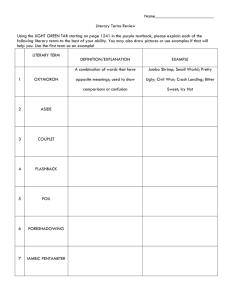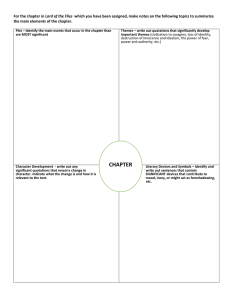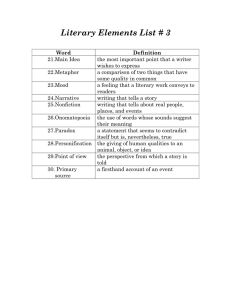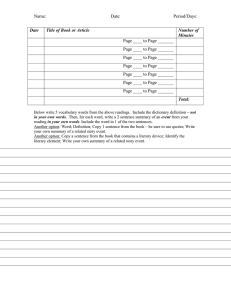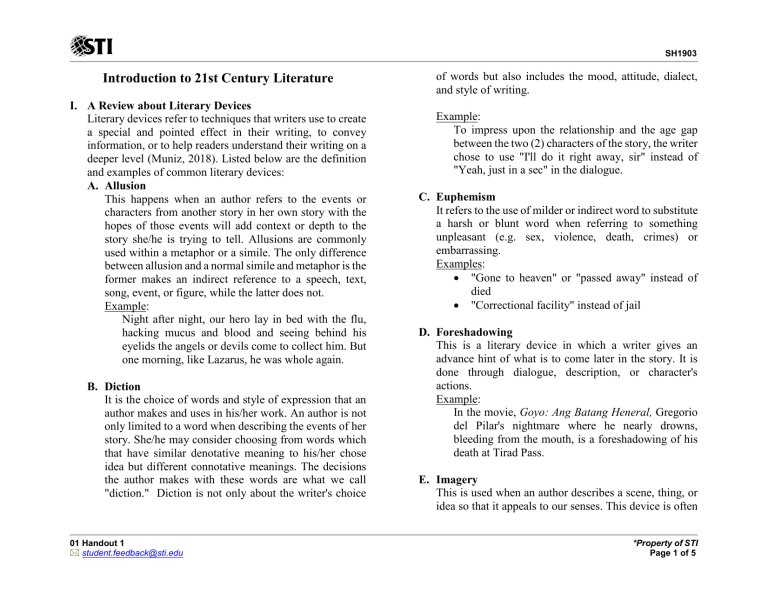
SH1903 Introduction to 21st Century Literature I. A Review about Literary Devices Literary devices refer to techniques that writers use to create a special and pointed effect in their writing, to convey information, or to help readers understand their writing on a deeper level (Muniz, 2018). Listed below are the definition and examples of common literary devices: A. Allusion This happens when an author refers to the events or characters from another story in her own story with the hopes of those events will add context or depth to the story she/he is trying to tell. Allusions are commonly used within a metaphor or a simile. The only difference between allusion and a normal simile and metaphor is the former makes an indirect reference to a speech, text, song, event, or figure, while the latter does not. Example: Night after night, our hero lay in bed with the flu, hacking mucus and blood and seeing behind his eyelids the angels or devils come to collect him. But one morning, like Lazarus, he was whole again. B. Diction It is the choice of words and style of expression that an author makes and uses in his/her work. An author is not only limited to a word when describing the events of her story. She/he may consider choosing from words which that have similar denotative meaning to his/her chose idea but different connotative meanings. The decisions the author makes with these words are what we call "diction." Diction is not only about the writer's choice 01 Handout 1 student.feedback@sti.edu of words but also includes the mood, attitude, dialect, and style of writing. Example: To impress upon the relationship and the age gap between the two (2) characters of the story, the writer chose to use "I'll do it right away, sir" instead of "Yeah, just in a sec" in the dialogue. C. Euphemism It refers to the use of milder or indirect word to substitute a harsh or blunt word when referring to something unpleasant (e.g. sex, violence, death, crimes) or embarrassing. Examples: • "Gone to heaven" or "passed away" instead of died • "Correctional facility" instead of jail D. Foreshadowing This is a literary device in which a writer gives an advance hint of what is to come later in the story. It is done through dialogue, description, or character's actions. Example: In the movie, Goyo: Ang Batang Heneral, Gregorio del Pilar's nightmare where he nearly drowns, bleeding from the mouth, is a foreshadowing of his death at Tirad Pass. E. Imagery This is used when an author describes a scene, thing, or idea so that it appeals to our senses. This device is often *Property of STI Page 1 of 5 SH1903 used to help the reader clearly visualize parts of the story by creating a strong mental picture. Example: The girl ran her hands on a soft satin fabric. F. Hyperbole It is the use of exaggeration to make a point. The hyperbole should not be taken literally and is often used for comedic effect and/or emphasis. Example: I am so tired I cannot walk another inch. G. Metaphor or Simile Metaphors are when ideas, actions, or objects are described in non-literal terms. In short, it is when an author compares one thing to another. The two (2) things being described usually share something in common but are different in all other respects. A simile is a type of metaphor in which an object, idea, character, action, etc., is compared to another thing using the words "as" or "like." Examples: • Tonyo's sweet is as big as a pearl due to the humid weather. (simile) • The book is a doorway to different parts of the world. (metaphor) H. Personification It is the technique where inanimate or nonliving objects were described as having human-like characteristics or qualities. 01 Handout 1 student.feedback@sti.edu Examples: • The fire swallowed the entire building. • "A tree that looks at God all day, And lifts her leafy arms to pray" — "Trees" by Joyce Kilmer I. Point of View The point of view determines the angle and perception in which the story is narrated or depicted. The first and third person point of view are the most common types that are used by writers. Examples: • First person It’s midnight and the moon shined so bright when I came to see my love. I was contemplating with the thought that I am so bad for killing my mother just to give her heart to the maiden I love. I’m on my way to my maiden, my legs were shaking, and my heart kept on pounding. The rain fell and I was so wet and I fell down to the ground crying, thinking of my mother who loved me so much. • Third person (unreliable) It’s dark and the moon shined so bright when the boy came out holding a heart. He left the dead body of a woman with a breast cut open. He was teary-eyed staring at the dead body but smiled when he opened his wallet and stared at the picture of a beautiful young lady. He glanced at the heart and said: “this is for the beautiful maiden.” He ran out holding the heart when it *Property of STI Page 2 of 5 SH1903 rained and he fell down and started to cry. He remembered the old woman he left at the house. • Third person (omniscient) It’s midnight and the moon shined so bright when the boy came to see the maiden he loves. He was contemplating with the thought that he is so bad for killing his own mother just to give her heart to the maiden. On his way, his legs were shaking, and his heart didn’t stop pounding. The rain fell and he was so wet when he fell to the ground, crying, thinking of his mother who loved him so much. J. Irony Irony is when a statement is used to express an opposite meaning than the one literally expressed by it. There are three (3) types of irony in literature: Verbal irony: It is when someone says something but means the opposite (similar to sarcasm). Example: On the way to school, the school bus gets a flat tire, and the bus driver says, "Excellent! This day couldn't start off any better!" Situational irony: It is when something happens which is the opposite of what was expected or intended to happen. Example: A traffic cop gets a traffic violation ticket due to an expired license. Dramatic irony: It is when the audience is aware of the true intentions or outcomes, while the characters are not. 01 Handout 1 student.feedback@sti.edu As a result, certain actions and/or events take on different meanings for the audience than they do for the characters involved. Example: In Romeo and Juliet, the audience knows that Juliet is only asleep, not dead, but Romeo does not and kills himself. K. Onomatopoeia It is the process of creating and using a word that phonetically imitates, resembles, or suggests the sound that it describes. Example: Justin was startled by the hiss of the approaching venomous snake. L. Metonymy and Synecdoche A metonym is when a related word or phrase is substituted for the actual thing to which it is referring. This device is usually used for poetic or rhetorical effect. Example: "The pen is mightier than the sword." This statement, which was coined by Edward Bulwer-Lytton in 1839, contains two (2) examples of metonymy: "the pen" refers to "the written word," and "the sword" refers to "military force/violence." A synecdoche is a literary device in which part of something is used to represent the whole or vice versa. It is similar to a metonym; however, a metonym does not have to represent the whole—just something associated with the word used. *Property of STI Page 3 of 5 SH1903 Example: The orator began his speech by saying, "Ladies and gentlemen, lend me your ears!" M. Paradox and Oxymoron A paradox is a statement that appears illogical or selfcontradictory but, upon investigation, might actually be true or plausible. Meanwhile, an oxymoron is a combination of two (2) words that expresses a contradictory meaning. This device is often used for emphasis, for humor, to create tension, or to illustrate a paradox. Note that a paradox is different from an oxymoron: a paradox is an entire phrase or sentence, whereas an oxymoron is a combination of just two words. Examples: • Deafening silence, original copy, clearly confused (oxymoron) • High walls make not a palace; full coffers make not a king. (paradox) N. Rhythm and Rhyme Rhyme refers to the recurrence of similar sounds in prose and poetry, while rhythm is the pattern of the poem, marked by stressed and unstressed syllables. Example: Twinkle, twinkle, little star, How I wonder what you are. Up above the world so high. Like a diamond in the sky. Twinkle, twinkle, little star, How I wonder what you are. 01 Handout 1 student.feedback@sti.edu O. Characterization Characterization in literature refers to the step-by-step process wherein an author introduces and then describes a character. The character can be described directly by the author or indirectly through the actions, thoughts, and speech of the character. Example: Danny was a poor fellow who lived in a small house. In spite of this, he is a jolly and generous person. P. Symbolism It refers to the use of an object, figure, event, situation, or other idea in a written work to represent something else. Examples: "Gold" as a symbol of wealth and power "Dove" as a symbol of peace II. Popular Themes and Forms in 21st Century Philippine Literature A. Themes According to Uychoco (2016), the prevalent themes in 21st Century Philippine Literature are poverty, gender inequality, identity, racism, justice system, and homesickness. The said themes mirror the dayto-day struggle and success of the Filipinos in the country and overseas. On the other hand, the technological advancements and events in this era resulted in the rise of themes such as technology and information age in World Literature (Walton, n.d.). Although themes such as uncontrolled and malign artificial intelligence technology, global warming, and international conflict seem appealing, not all the *Property of STI Page 4 of 5 SH1903 writers of this era embraced it. Many were still more disposed to look back because they find greater imaginative stimulus in the past than in the present and the future (Encyclopaedia Britannica, 2019). The aforementioned themes are evident in the literary pieces included in The Journal of Contemporary Philippine Literature by University of the Philippines. Try reading the short story Troll by Nicko Manipis de Guzman and Ang Paglalakbay ng Isang Kwento: Si Guacu, and Hunk na Lumpo by Jov Almero, the poem Tarpo and Panalangin ng Isang Pedicab Driver by Genaro Gojo Cruz, and the essay "Ang Mapa ng Taglagas sa Aking Maleta" by Eugene Evasco, and see how ideas in the said pieces revolved around themes such as poverty, justice, technology, history, and identity. B. Forms The contemporary forms of Philippine literature evolved from the old forms from the previous centuries. In poetry, we have textula, textanaga, rap battle or FlipTop, and spoken word poetry. Textula and textanaga, an amalgam of "text messaging" and poetic forms tula and tanaga, are brought by the booming use of text messaging in the country (Yuson, 2003). The rap battle or FlipTop started in 2010 and considered by many as the modern balagtasan infused with hip hop culture (Angeles, 2014). Lastly, with the help of artists such as Sarah and Phil Kaye and Juan Miguel Severo, the love of the Filipinos for spoken word poetry has been rekindled (Guariña, 2016). 01 Handout 1 student.feedback@sti.edu References: Angeles, M. (2014, March 1). Is FlipTop the modern-day Balagtasan? Retrieved from https://www.gmanetwork.com/news/lifestyle/artandculture/350760/isfliptop-the-modern-day-balagtasan/story Guariña, C. (2016, October 9). Watch: 10 Pinoy spoken word artists who caught our attention! Retrieved from https://myx.abscbn.com/features/3722/watch-10-pinoy-spoken-word-artists-whocaught-our-attention Kemp, P. (2019, February 4). The 21st century. In Encyclopaedia Britannica. Retrieved from https://www.britannica.com/art/Englishliterature/The-21st-century Literary devices. (n.d.). Retrieved from https://literarydevices.com/content/allegory Literary devices. (n.d.). Retrieved from http://www.literarydevices.com/diction Literary devices: definition & examples. (n.d.). Retrieved from https://study.com/academy/lesson/literary-devices-definition-examplesquiz.html Muniz, H. (2018, June 21). The 31 literary devices you must know. Retrieved from https://blog.prepscholar.com/list-of-literary-devicestechniques Onomatopoeia. (n.d.). Retrieved from https://en.oxforddictionaries.com/explore/words-that-sound-like-thething-they-describe Uychoco, M. (2016). 21st century literature from the Philippines and the world. Manila: Rex Book Store, Inc. Walton, A. (n.d.). Themes in literature in the 21st century. Retrieved from https://classroom.synonym.com/themes-literature-21st-century8320321.html Yuson, A. (2003, February 17). Singatoons & textanaga. Philstar. Retrieved from https://www.philstar.com/lifestyle/arts-andculture/2003/02/17/195759/singatoons-amp-textanaga *Property of STI Page 5 of 5
